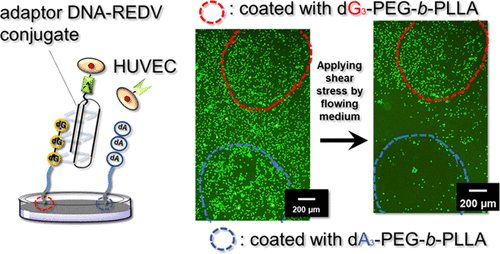当前位置:
X-MOL 学术
›
Biomacromolecules
›
论文详情
Our official English website, www.x-mol.net, welcomes your feedback! (Note: you will need to create a separate account there.)
Versatile Cell-Specific Ligand Arrangement System onto Desired Compartments of Biodegradable Matrices for Site-Selective Cell Adhesion Using DNA Tags.
Biomacromolecules ( IF 6.2 ) Pub Date : 2020-07-27 , DOI: 10.1021/acs.biomac.0c00814 Hiromichi Sumida 1 , Yuta Yoshizaki 2 , Akinori Kuzuya 1 , Yuichi Ohya 1, 3
Biomacromolecules ( IF 6.2 ) Pub Date : 2020-07-27 , DOI: 10.1021/acs.biomac.0c00814 Hiromichi Sumida 1 , Yuta Yoshizaki 2 , Akinori Kuzuya 1 , Yuichi Ohya 1, 3
Affiliation

|
A promising approach for the regeneration of tissues or organs with three-dimensional hierarchical structures is the preparation of scaffold-cell complexes that mimic these hierarchical structures. This requires an effective technique for immobilizing cell-specific ligands at arbitrarily chosen positions on matrices. Here, we report a versatile system for arranging cell-specific ligands onto desired compartments of biodegradable matrices for site-selective cell arrangement. We utilized the specific binding abilities of specific DNAs, immobilizing them as tags to arrange cell-recognition ligands at desired areas of the matrices by specific binding with cell-recognition ligand–DNA conjugates. We synthesized poly(l-lactide) (PLLA), a biodegradable polymer, with an oligo-DNA (trimer of deoxyguanosine: dG3) attached via a poly(ethylene glycol) (PEG) spacer to generate dG3-PEG-b-PLLA. The peptides Arg-Gly-Asp-Ser (RGDS) and Arg-Glu-Asp-Val (REDV) were chosen as cell-recognition ligands and were attached to an adapter DNA (aDNA), which can specifically bind to the dG3 moiety through G-quadruplex formation. The obtained dG3-PEG-b-PLLA was deposited on a small spot of the PLLA film, and the aDNA–RGDS or aDNA–REDV conjugate was added on the film to immobilize these ligands at the spot. We confirmed the specific adhesion of L929 cells (a mouse fibroblast cell line) and human umbilical vein endothelial cells (HUVECs) on the small areas coated with dG3-PEG-b-PLLA in the presence of aDNA–RGDS and aDNA–REDV, respectively, even after applying shear stress by flowing medium across the spot. Cell-specific attachment of the target cells was effectively achieved in a spatially controlled manner. This technique has the potential for the construction of cell–scaffold complexes that mimic the hierarchical structures of natural organs and may represent a breakthrough in realizing regenerative medicine and tissue engineering of complex organs.
中文翻译:

通用的细胞特异性配体排列系统,可用于使用DNA标签进行位点选择性细胞粘附的可生物降解基质的所需隔室。
具有三维层次结构的组织或器官再生的一种有前途的方法是制备模仿这些层次结构的支架细胞复合物。这需要用于将细胞特异性配体固定在基质上任意选择的位置的有效技术。在这里,我们报告了一种通用的系统,用于将细胞特异性配体布置在可生物降解基质的所需区室上,以进行位点选择性细胞排列。我们利用了特定DNA的特异性结合能力,将它们固定为标签,通过与细胞识别配体-DNA共轭物的特异性结合,将细胞识别配体排列在基质的所需区域。我们合成了聚(l-丙交酯)(PLLA),一种可生物降解的聚合物,带有一个寡聚DNA(脱氧鸟苷三聚体:dG3)通过聚(乙二醇)(PEG)间隔基连接以产生dG 3 -PEG- b- PLLA。选择肽Arg-Gly-Asp-Ser(RGDS)和Arg-Glu-Asp-Val(REDV)作为细胞识别配体,并连接到可以特异性结合dG 3部分的衔接子DNA(aDNA)上。通过G-四链体形成。将获得的dG 3 -PEG- b -PLLA沉积在PLLA膜的一个小点上,然后在膜上添加aDNA-RGDS或aDNA-REDV共轭物以将这些配体固定在该点上。我们证实了L929细胞(小鼠成纤维细胞系)和人脐静脉内皮细胞(HUVEC)在涂有dG 3 -PEG- b的小区域上的特异性粘附-a PLLA分别存在aDNA–RGDS和aDNA–REDV的情况下,即使通过使介质流过斑点施加剪切应力也是如此。以空间控制的方式有效地实现了靶细胞的细胞特异性附着。该技术具有构建模仿自然器官分层结构的细胞支架复合物的潜力,并且可能代表着实现复杂器官的再生医学和组织工程学方面的突破。
更新日期:2020-09-14
中文翻译:

通用的细胞特异性配体排列系统,可用于使用DNA标签进行位点选择性细胞粘附的可生物降解基质的所需隔室。
具有三维层次结构的组织或器官再生的一种有前途的方法是制备模仿这些层次结构的支架细胞复合物。这需要用于将细胞特异性配体固定在基质上任意选择的位置的有效技术。在这里,我们报告了一种通用的系统,用于将细胞特异性配体布置在可生物降解基质的所需区室上,以进行位点选择性细胞排列。我们利用了特定DNA的特异性结合能力,将它们固定为标签,通过与细胞识别配体-DNA共轭物的特异性结合,将细胞识别配体排列在基质的所需区域。我们合成了聚(l-丙交酯)(PLLA),一种可生物降解的聚合物,带有一个寡聚DNA(脱氧鸟苷三聚体:dG3)通过聚(乙二醇)(PEG)间隔基连接以产生dG 3 -PEG- b- PLLA。选择肽Arg-Gly-Asp-Ser(RGDS)和Arg-Glu-Asp-Val(REDV)作为细胞识别配体,并连接到可以特异性结合dG 3部分的衔接子DNA(aDNA)上。通过G-四链体形成。将获得的dG 3 -PEG- b -PLLA沉积在PLLA膜的一个小点上,然后在膜上添加aDNA-RGDS或aDNA-REDV共轭物以将这些配体固定在该点上。我们证实了L929细胞(小鼠成纤维细胞系)和人脐静脉内皮细胞(HUVEC)在涂有dG 3 -PEG- b的小区域上的特异性粘附-a PLLA分别存在aDNA–RGDS和aDNA–REDV的情况下,即使通过使介质流过斑点施加剪切应力也是如此。以空间控制的方式有效地实现了靶细胞的细胞特异性附着。该技术具有构建模仿自然器官分层结构的细胞支架复合物的潜力,并且可能代表着实现复杂器官的再生医学和组织工程学方面的突破。


























 京公网安备 11010802027423号
京公网安备 11010802027423号